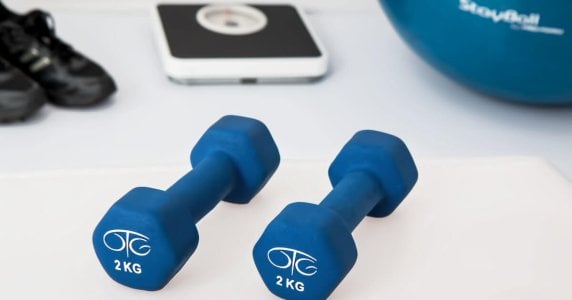Is walking just 4 hours a week the secret to an increased pain threshold?
- Replies 5
We know that staying active is crucial for our overall health and well-being.
But did you know that walking for just four hours a week can improve your pain tolerance, potentially decreasing the need for painkillers to cope with everyday health concerns such as headaches and back pain?
A recent study conducted by researchers at the University Hospital of North Norway sought to investigate the relationship between physical activity and pain tolerance.
Involving over 10,700 participants aged between 30 and 87, the study required them to categorise their average physical activity levels over the past year.
Participants could select from the following categories: vigorous activity for those involved in training or sports competitions several times a week or moderate activity for those partaking in activities such as tennis or heavy gardening for at least four hours weekly.
They were also asked to select light activity if they walked, cycled, or did similar exercises for a minimum of four hours a week, or sedentary for those who typically engaged in sitting activities.
The study measured participants’ pain tolerance by asking them to submerge their hands in cold water for as long as they could endure.
And the results were astounding.
Those in the vigorous activity group were able to keep their hands submerged for 16 seconds longer than the sedentary individuals.
Even the light activity participants (those who walked or cycled) showed an increased tolerance by almost seven seconds compared to their sedentary counterparts.
It is common knowledge that exercise helps to reduce everyday aches and pains by maintaining joint flexibility. However, the study's findings suggest that fitter individuals may experience less pain.
Anders Arnes, the study’s principal researcher, explained that exercise might affect the same pathways in the brain as painkillers like morphine, albeit to a much smaller degree.
He said: ‘Our results suggest regular physical activity can help improve pain tolerance, just like the so-called “runner's high” we get after a jog can make pain seem less painful.’
‘There are studies suggesting people who are more active use painkillers less often, and we wonder if these effects from being active could even make things like childbirth feel a bit less painful, although far more research would be needed to establish that,’ he continued.
Further research into the subject is needed.
Nevertheless, this study highlights the benefits of adopting a moderately active lifestyle, potentially contributing to a reduced need for pain management treatments.
So, for our Seniors Discount Club members, if possible, it’s time to embrace a more active lifestyle!
Aim for at least four hours of walking or similar physical activity each week.
As the study concludes: ‘Becoming or staying physically active over time can benefit your pain tolerance. Whatever you do, the most important thing is that you do something.’ And we agree!
Not only will this benefit your overall health, but it may just make those daily aches and pains a little more bearable.
Incorporating walking or other low-impact activities like swimming or yoga into your weekly routine can also do wonders for your mental health and general well-being.
 If, for whatever reason, pain persists, make sure to consult with your doctor to see what you’re comfortable with.
If, for whatever reason, pain persists, make sure to consult with your doctor to see what you’re comfortable with.
Take care, and keep moving!
But did you know that walking for just four hours a week can improve your pain tolerance, potentially decreasing the need for painkillers to cope with everyday health concerns such as headaches and back pain?
A recent study conducted by researchers at the University Hospital of North Norway sought to investigate the relationship between physical activity and pain tolerance.
Involving over 10,700 participants aged between 30 and 87, the study required them to categorise their average physical activity levels over the past year.
Participants could select from the following categories: vigorous activity for those involved in training or sports competitions several times a week or moderate activity for those partaking in activities such as tennis or heavy gardening for at least four hours weekly.
They were also asked to select light activity if they walked, cycled, or did similar exercises for a minimum of four hours a week, or sedentary for those who typically engaged in sitting activities.
The study measured participants’ pain tolerance by asking them to submerge their hands in cold water for as long as they could endure.
And the results were astounding.
Those in the vigorous activity group were able to keep their hands submerged for 16 seconds longer than the sedentary individuals.
Even the light activity participants (those who walked or cycled) showed an increased tolerance by almost seven seconds compared to their sedentary counterparts.
It is common knowledge that exercise helps to reduce everyday aches and pains by maintaining joint flexibility. However, the study's findings suggest that fitter individuals may experience less pain.
Anders Arnes, the study’s principal researcher, explained that exercise might affect the same pathways in the brain as painkillers like morphine, albeit to a much smaller degree.
He said: ‘Our results suggest regular physical activity can help improve pain tolerance, just like the so-called “runner's high” we get after a jog can make pain seem less painful.’
‘There are studies suggesting people who are more active use painkillers less often, and we wonder if these effects from being active could even make things like childbirth feel a bit less painful, although far more research would be needed to establish that,’ he continued.
Further research into the subject is needed.
Nevertheless, this study highlights the benefits of adopting a moderately active lifestyle, potentially contributing to a reduced need for pain management treatments.
So, for our Seniors Discount Club members, if possible, it’s time to embrace a more active lifestyle!
Aim for at least four hours of walking or similar physical activity each week.
As the study concludes: ‘Becoming or staying physically active over time can benefit your pain tolerance. Whatever you do, the most important thing is that you do something.’ And we agree!
Not only will this benefit your overall health, but it may just make those daily aches and pains a little more bearable.
Incorporating walking or other low-impact activities like swimming or yoga into your weekly routine can also do wonders for your mental health and general well-being.
Key Takeaways
- Walking for four hours a week can improve your tolerance for pain, potentially reducing the need for painkillers.
- Researchers found that people who engaged in light activity, such as walking or cycling for at least four hours a week, could withstand pain for longer than sedentary people.
- Regular physical activity may have an effect on the same pathways in the brain as painkillers like morphine, albeit to a far smaller degree.
- The study suggests that becoming or staying physically active over time can benefit your pain tolerance, emphasising the importance of engaging in physical activity.
Take care, and keep moving!









